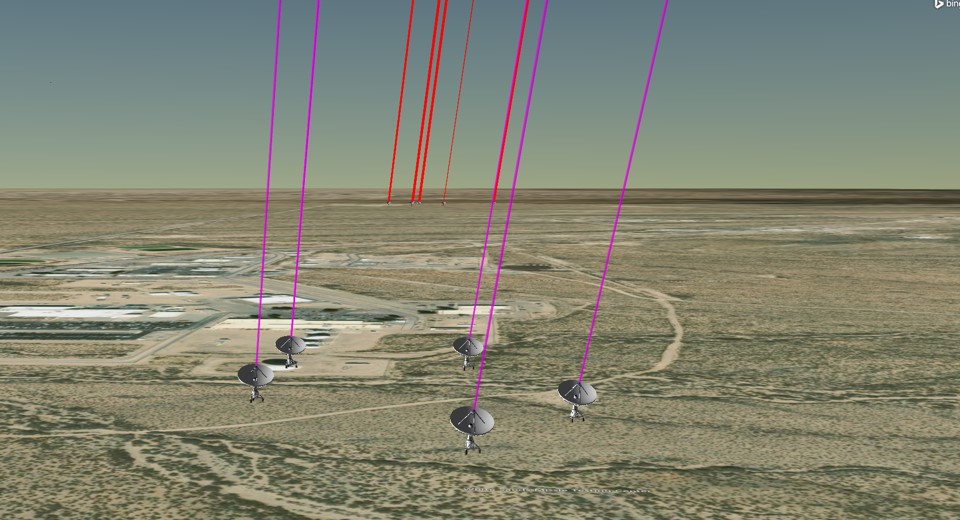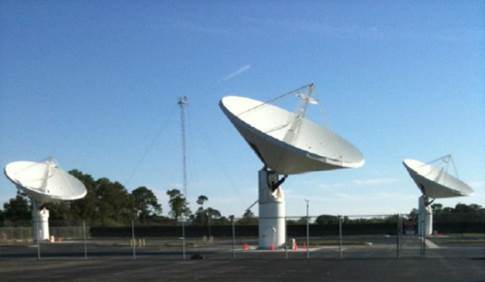Self-Controlled
Self-calibrating; no external objects needed
Our Self-Controlled arraying technology comprehensively and automatically calibrates itself. Everything’s done internally and on the ground. It was considered by NASA HQ to be the only operationally feasible solution to the widely-spaced large reflector arraying problem. If it’s ON, it’s ready for your mission, 24/7.
Background
Specialized Arrays has invented two distinct methods to keep the antennas in the array synchronized or coherent. The method selected is mission-dependent.
- Self-Controlled
- Feedback-Controlled
Self-Controlled calibration is ideal for very large arrays of widely-spaced ground reflectors for both COMM and RADAR missions. We demonstrated both coherent transmit and calibrated receive arraying using this technology in 2010 on a NASA-funded program. It is at a TRL-6.
Feedback-Controlled calibration was designed for applications, such as quick deployable tactical missions, where installing fixed, stable antennas, connected with fiber and wires is not feasible and where a single large dish would be an easy target.
Description
For large, widely-spaced ground antenna arrays, the optimal method is Self-Controlled. The antennas rely only on themselves. They don’t require feedback from towers or Space objects. The system is calibrated, instantly, by design, from the moment it is powered up. This method features:
- 24/7 availability
- No need to point away from the target to recalibrate
- No drifting out of phase
- Continuous, autonomous, optimal coherency for the ‘perfect’ beam
- 24/7 reliability for GEO monitoring, Space COMM and DE missions
In order to achieve the combined radiated power benefit of an array of antennas, each element must ensure that its signal arrives at the target precisely synchronized with signals from all the others. If it does not, the array beam will be reduced in power and deflected away from the target. In a worst-case synchronization error, significant destructive interference due to imperfect synchronization can result. Instead of an intended maximum power beam the result can be nearly zero power directed at the target.
Variations within the antennas, HPAs and feeds, the internal array circuitry and fiber cause the array to lose synchronization. These components continuously drift with temperature and time. This drift increases as the number of antennas, the separation, and the frequency increases.
With our locally Self-Controlled system, all synchronization errors are corrected BEFORE the signal is transmitted, without needing or using any feedback from remote objects. Information as to how to adjust the individual antennas for synchronization is provided internally and locally, within the array.
Example


The Self-Controlled Method can be used for applications such as GEO asset monitoring and Deep Space Communications. For a link to our 43+ page AIAA invited book chapter, please click here.
Until about 2008, widely-spaced array transmit beamforming was considered an intractable problem. However, between 2008 and 2010, three demonstrations funded by NASA proved it was possible. Two of the demonstrations (both by JPL) used feedback from remote objects (ground towers and the Moon) to synchronize the antennas. However, for both demonstrations, the array inevitably drifted out of calibration and required periodic recalibration. In between calibration events, the state of the system is unknown.
Our method, the third NASA demonstration, used Self-Controlled calibration. The antenna array continually maintained calibration with internal closed loops which sensed and corrected any errors as they developed, never needing any external objects.
The array of three 12m reflectors remained calibrated 24/7 throughout the entire six months of operation (until powered down). It operated at X-band, maintaining ideal beamforming performance with less than 0.2dB loss, even under tropical storm weather. NASA headquarters recognized this accomplishment with Exceptional Engineering Achievement Medals in 2011.
